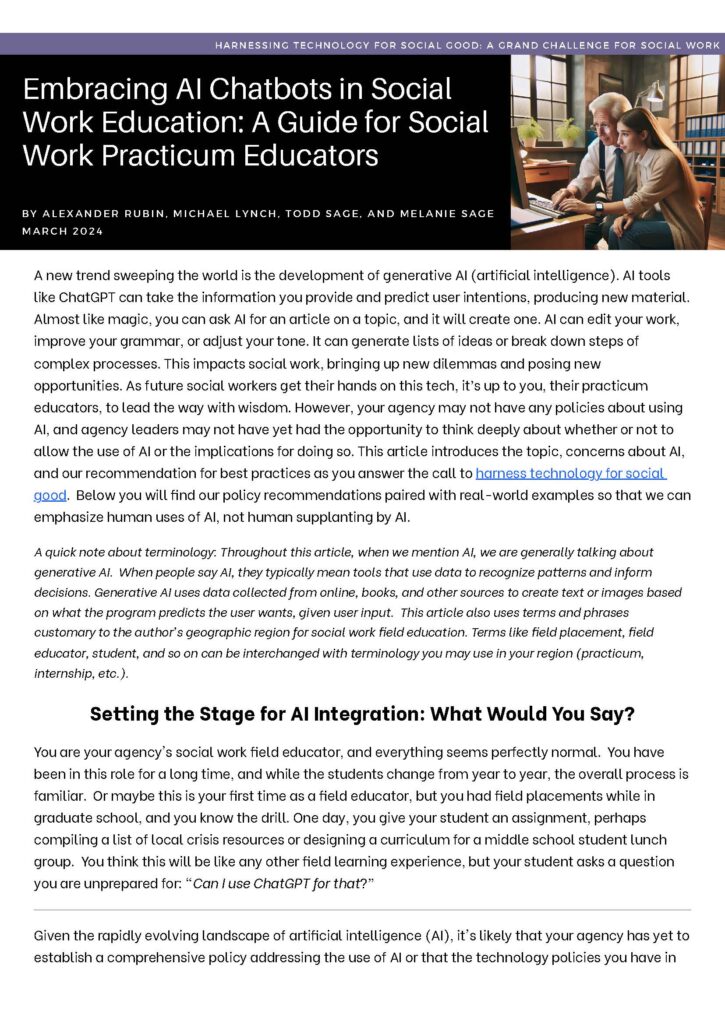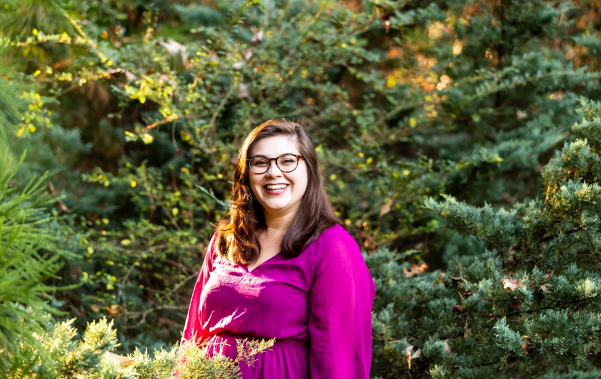Navigating AI in Social Work Education
Editor’s note: In this blog post, four social worker educators share a sample from their new and free resource about using Artificial Intelligence (AI) in social work education. Alexander Rubin, LCSW, is a clinical assistant professor based in field education at the University at Buffalo School of School of Social Work. He specializes in community partnership development, field-specific teaching, and innovation in field education. Michael Lynch, LMSW, is a clinical associate professor at the University at Buffalo School of Social Work. He specializes in experiential learning, community partnerships, and the use of technology in social work practice and education. Todd Sage, Ph.D., MSW, is a clinical associate professor at the University at Buffalo School of Social Work. He is the chemical dependency track coordinator and mental health track chair. He researches technology and child welfare and enjoys integrating emerging technologies in the classroom and as a field instructor. Melanie Sage, Ph.D., LCSW, is a tech consultant for universities, social work departments, and social work agencies. She is an expert in generative AI, machine learning in social work, social media use, online education, and teaching with technology. She also works with agencies to train staff in Motivational Interviewing.
As social work educators, we find ourselves at a point where the capabilities of generative artificial intelligence (AI) tools like ChatGPT intersect with our professional practice more and more often, and we ponder these challenges with much philosophical debate in academic settings. But we send our students out to their practicum sites, and the debates are no longer philosophical; real-life decisions affect agencies, students, and clients, and these challenges must be thoughtfully and practically addressed. The emergence of AI has outpaced the development of comprehensive policy in numerous professional settings. This is why we wrote an article to offer guidance and considerations for the social work field educator with a student placed in their agency. Our goal is to introduce use cases, debates, and potential policies. The full article can be downloaded here and shared with your local social services agencies.
Using Artificial Intelligence in Social Work Field Education
Editor’s Note: Jacqueline Jones is the MSW Field Coordinator at the University of Alabama at Birmingham and one of my colleagues in the UAB Department of Social Work. She has over six years of experience supervising students during field placements and eight years of social work practice experience. In this blog post, she shares how she uses artificial intelligence tools to improve her teaching and save time.
I think, in many ways, social workers shy away from technology and, seemingly, advanced computer systems. In an ever-evolving world where social media, email, and searching the World Wide Web are literally at our fingertips, I believe social workers should embrace the use of technology in their practice and what it is capable of doing to help not only us but our clients, too.
I will expand on using one specific realm of technology in social work education: artificial intelligence or AI. Currently, I serve as the Masters of Social Work (MSW) Field Coordinator at the University of Alabama at Birmingham, which means teaching seminar courses for field education. This semester, I decided to use AI to assist me in developing in-class activities for my MSW students.
What is AI? Here is the answer that ChatGPT gave me in a matter of seconds to give you a glimpse of what AI can do.
The Role of the Interpretation Guide in the Self-Study: CSWE Accreditation
Editor’s note: Melissa Freedman, MSW, is a social work educator and consultant specializing in leadership, supervision, administration, and quality management and assurance. In this blog post, she shares an overview of the interpretation guide to write a self-study for social work accreditation by the Council on Social Work Education (CSWE). I found using CSWE’s interpretation guide both useful and overwhelming at the same time, and the tips that Melissa shares in this post helped break down the guide for me. She can be reached via email at freedman121@comcast.net.
As a social work program navigating the accreditation process, this blog post assumes you have created a work plan, identified your core accreditation team members and their roles, assigned writing responsibilities to these team members and/or other key individuals, and started to develop an internal timeline for task completion. If you are still contemplating how to start the self-study process or have not yet addressed all key planning steps, you may read the Five Steps to Planning your Social Work Program’s Self-Study: CSWE Accreditation the first blog post in this series on CSWE Accreditation.
Before social work programs begin writing their self-study(ies), I vehemently encourage them to follow a few recommendations. First, to actively use the interpretation guide. Second, TO ACTIVELY USE THE INTERPRETATION GUIDE!
What is the interpretation guide? CSWE identifies it as the “official companion document” to Educational Policy and Accreditation Standards (EPAS). Currently, there are two versions of the guide available: one for social work programs seeking accreditation under the 2015 EPAS and another for programs seeking accreditation under the 2022 EPAS. Here are the links to the most recent version of each guide:
Five Steps to Planning your Social Work Program’s Self-Study: CSWE Accreditation
Editor’s note: Melissa Freedman, MSW, is a social work educator and consultant specializing in leadership, supervision, administration, and quality management and assurance. In this blog post, she shares guidance for social work educators about how to start planning for the important task of reaffirmation and the initial process of accreditation with the Council on Social Work Education. I can also envision social work faculty and staff applying these guidelines to the adoption of new accreditation standards and policies and sharing them with institutional leadership when asking for support and resources. She can be reached via email at freedman121@comcast.net.
The time has come to begin writing your accreditation self-study with the Council of Social Work Education (CSWE). As with any major project, preparation and planning are key. Simple, right? And then it’s time to put the metaphorical pen to paper, and the landslide of anxiety and overwhelming doubt begins. To help alleviate some of the agony, this blog serves to provide introductory guidance to identify your accreditation team and the initial tasks necessary to develop the most appropriate plan of action for your program(s). This guidance stems from my years of a career spent in leadership, training, and quality management and assurance. I will start with this…it truly takes a village, and writing a self-study should never be a siloed process.
How Becoming an Adjunct Improved My Social Work Practice
Editor’s Note: Christa McCrorie (she/her), LICSW-PIP, is an adjunct instructor at the University of Alabama at Birmingham and a social worker with a private practice, Creative Therapeutic Solutions, LLC, where she specializes in queer needs and trauma processing. In this blog post, she shares how her time as an adjunct instructor has improved her own social work practice and offers reflection prompts for those interested in adjunct teaching as a social worker. You can reach her through her practice at https://creativetherapeutic.solutions/
As someone with almost ten years of experience as a social worker, I had already branched into independent roles; I was leading my own private practice, was providing supervision to master’s level social workers, and was frequently asked to consult for publications in niche mental health topics such as stress management for teens, and queer education. I enjoyed all of it, but one of my personal goals has been to shift into a teaching role, and contributing as an adjunct professor for the local university’s social work educational program seemed like a great fit. After seeking this position for several years, I finally found an opportunity in 2022 and was signed up for my first class!






